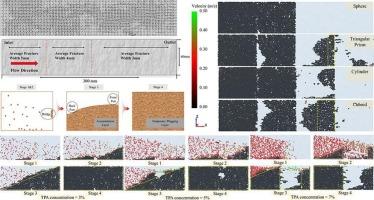Investigation of temporary plugging agents transport and plugging behavior in fractures using CFD-DEM coupling method
IF 4.6
2区 工程技术
Q2 ENGINEERING, CHEMICAL
引用次数: 0
Abstract
Intra-fracture temporary plugging fracturing is an effective technique for the creation of multi-level branched fractures. The transport and plugging performance of temporary plugging agents (TPAs) within fractures directly determines the efficiency of the fracturing operation. However, there are few studies addressing the growth mechanisms of the plugging layer, and the influence of key TPA physical properties (such as particle shape and friction coefficient) on plugging efficiency remains poorly understood. This lack of understanding hinders the theoretical foundation necessary for the optimized design of intra-fracture temporary plugging strategies. In this study, a high-fidelity numerical model based on a coupled CFD–DEM approach, which accurately accounts for particle–particle contact and collision behaviors, was developed to simulate the transport and plugging process of TPAs within fractures. A comprehensive investigation was conducted to understand the plugging behavior under varying operational parameters. The results indicate that the growth of the plugging layer follows four distinct stages, different operational parameters primarily influence the growth characteristics by altering the particle sedimentation rates at the front and rear of the accumulation zone. An increase in friction coefficient enhances bridging capability and results in a 74.07 % reduction in plugging layer length. Small-diameter TPAs (1.2 mm) exhibit poor plugging performance due to their low bridging probability, which can be improved through synergistic injection of mixed particle sizes. Irregular-shaped particles form interlocking structures via multi-point contacts, enhancing the mechanical stability of the plugging layer. An optimal TPA density range of 1120–1300 kg·m−3 is recommended.

利用CFD-DEM耦合方法研究暂堵剂在裂缝中的运移及封堵行为
裂缝内暂堵压裂是制造多级分支裂缝的有效技术。暂堵剂(tpa)在裂缝内的运移和封堵性能直接决定了压裂作业的效率。然而,关于堵层生长机制的研究很少,TPA关键物理性质(如颗粒形状和摩擦系数)对堵层效率的影响仍然知之甚少。这种认识的缺乏阻碍了裂缝内临时封堵策略优化设计所需的理论基础。在本研究中,基于CFD-DEM耦合方法建立了一个高保真的数值模型,该模型准确地反映了颗粒之间的接触和碰撞行为,模拟了tpa在裂缝内的运移和堵塞过程。为了了解不同操作参数下的堵塞行为,进行了全面的调查。结果表明:堵层的生长经历了四个不同的阶段,不同的操作参数主要通过改变堆积带前后的颗粒沉降速率来影响堵层的生长特征。摩擦系数的增加提高了桥接能力,堵漏层长度减少了74.07%。小直径tpa (1.2 mm)由于桥接概率低,堵塞性能较差,可以通过混合粒径的协同注入来改善。不规则形状的颗粒通过多点接触形成连锁结构,增强了堵层的机械稳定性。TPA的最佳密度范围为1120 ~ 1300 kg·m−3。
本文章由计算机程序翻译,如有差异,请以英文原文为准。
求助全文
约1分钟内获得全文
求助全文
来源期刊

Powder Technology
工程技术-工程:化工
CiteScore
9.90
自引率
15.40%
发文量
1047
审稿时长
46 days
期刊介绍:
Powder Technology is an International Journal on the Science and Technology of Wet and Dry Particulate Systems. Powder Technology publishes papers on all aspects of the formation of particles and their characterisation and on the study of systems containing particulate solids. No limitation is imposed on the size of the particles, which may range from nanometre scale, as in pigments or aerosols, to that of mined or quarried materials. The following list of topics is not intended to be comprehensive, but rather to indicate typical subjects which fall within the scope of the journal's interests:
Formation and synthesis of particles by precipitation and other methods.
Modification of particles by agglomeration, coating, comminution and attrition.
Characterisation of the size, shape, surface area, pore structure and strength of particles and agglomerates (including the origins and effects of inter particle forces).
Packing, failure, flow and permeability of assemblies of particles.
Particle-particle interactions and suspension rheology.
Handling and processing operations such as slurry flow, fluidization, pneumatic conveying.
Interactions between particles and their environment, including delivery of particulate products to the body.
Applications of particle technology in production of pharmaceuticals, chemicals, foods, pigments, structural, and functional materials and in environmental and energy related matters.
For materials-oriented contributions we are looking for articles revealing the effect of particle/powder characteristics (size, morphology and composition, in that order) on material performance or functionality and, ideally, comparison to any industrial standard.
 求助内容:
求助内容: 应助结果提醒方式:
应助结果提醒方式:


